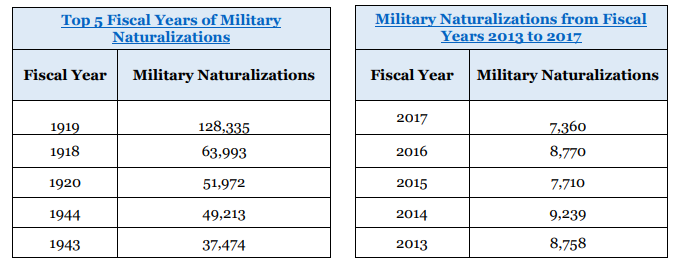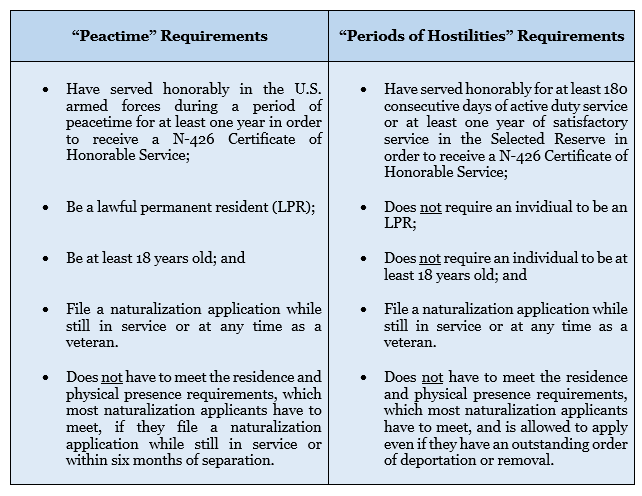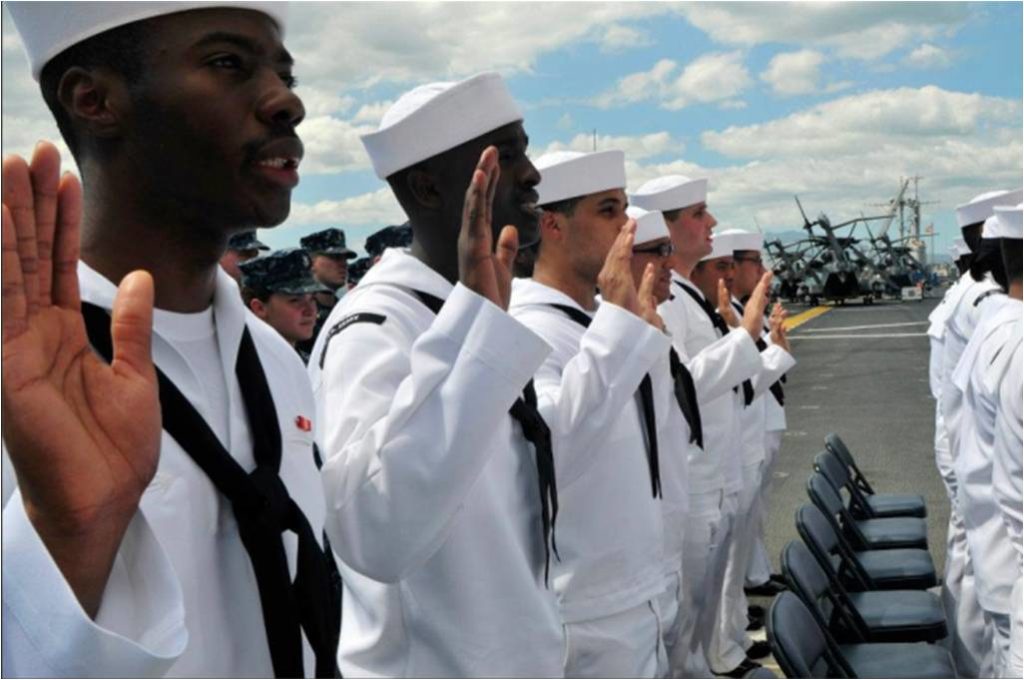The United States permits individuals who are not U.S. citizens to enlist in the military and, in recognition of their military service, naturalize more quickly. The U.S. is home to thousands of non-citizen military service members and veterans who may be eligible to become U.S. citizens but have not naturalized. This document provides an overview of the rules and process that govern naturalization for military service members and veterans, assistance for military and veterans naturalization, the naturalization process for military family members and the number of non-citizen military service members and veterans who have obtained U.S. citizenship.
Background Facts
Immigrants in the Military
Immigrants play a vital role in our nation’s military. An estimated 40,000 immigrants served in the U.S. armed forces in 2015 and about 5,000 non-citizens enlist in the military each year.
Meanwhile, approximately 94,000 immigrant veterans do not have U.S. citizenship. The U.S. is home to 511,000 foreign-born veterans. Of these, 417,000 veterans, or about 82 percent, are naturalized citizens. The remaining veterans have yet to naturalize, with no access to the rights and opportunities conferred by U.S. citizenship. Immigrant veterans come from a diverse group of countries. The top birth countries of foreign-born veterans were Mexico (83,000), the Philippines (68,000), Germany (33,000) and Canada (31,000).
Immigrants in America have served in the military with distinction. More than 700 – or more than 20 percent – of the 3,500 Medal of Honor recipients are immigrants.
Military Naturalizations: A Recent Decline
Between Oct. 1, 2001 and Sept. 30, 2017, more than 125,000 military service members naturalized. In fiscal year (FY) 2017, U.S. Citizenship and Immigration Services (USCIS) conducted 7,360 military naturalizations, a decrease of 16 percent compared to FY 2016 (8,770 military naturalizations) and well below the all-time high in FY 1919 (128,335 military naturalizations).

More recently, military naturalizations dropped almost 65 percent in the first quarter of FY 2018 compared to the fourth quarter of FY 2017, plummeting to 755 naturalizations from 2,123 in the previous quarter. At the same time, the rate of military naturalizations denied by USCIS increased from 10 percent in the fourth quarter of FY 2017 to 25 percent in the first quarter of FY 2018. The drop in military naturalizations and increase in the percentage of denied applications came after the DoD’s policy changes to the expedited naturalization process for military service members and veterans. This policy change has already had a tangible effect on military and veterans naturalizations, limiting the number of service members eligible to apply for naturalization today and potentially leading to the lowest number military naturalizations since FY 2000.
The most recent USCIS data indicates that the recent drop in military naturalizations is unlikely to abate. Military naturalizations declined 57 percent in the first six months of FY 2018 compared to the first six months of FY 2017, dropping to 1,175 military naturalizations from 2,716 in the previous year.
Deported Veterans
There are at least 239 deported veterans living in 34 countries. Immigrant military service members and veterans who are not U.S. citizens are susceptible to deportation if they commit certain offenses, even if they served honorably in the military. It is important to screen clients who might be eligible for Naturalization to ensure they are protected from deportation.
Basics of Military and Veterans Naturalization
Determining eligibility. The Immigration and Nationality Act (INA) establishes different eligibility requirement for citizenship for non-citizen service members and certain veterans who served during periods of “peacetime” (INA § 328) or “hostilities” (INA § 329). The U.S. has been in a period of hostility since September 11, 2001.[1]

Both INA sections 328 and 329 require military service members or veterans applying for citizenship to demonstrate good moral character, knowledge of the English language, knowledge of U.S. government and history (“civics”), and attachment to the principles of the U.S. constitution.
Obtaining certification of honorable service. A military service member applying for naturalization under INA section 328 or 329 must obtain a certification of honorable service on Form N-426 (Request for Certification of Military or Naval Service) before applying for naturalization. There is no fee for Form N-426.
The Form N-426 must be certified by the Secretary of the applicable Military Department or a commissioned officer serving in the pay grade of O-6 or higher (usually a U.S. Army, Marine Corps and Air Force Colonel or a Navy and Coast Guard Captain, or higher). The USCIS website also states that the service member’s commanding officer may certify Form N-426.[3]
A veteran applying for naturalization under INA section 328 or 329 does not need to obtain a certified N-426. Instead veterans will use their discharge papers, DD214 and NGB22, to show services and honorable discharge.
Submitting naturalization application and required documents. A military service member must submit to USCIS a completed Form N-400 (Application for Naturalization) and the certified Form N-426 to apply for naturalization.
Military service members serving overseas on orders can apply for naturalization. The individual can request overseas processing by attaching a cover letter to their application, or at any time in the naturalization process by contacting the Military Help Line at 877-CIS-4MIL (877-247-4645) or militaryinfo@uscis.dhs.gov.
A veteran applying for naturalization under INA section 328 or 329 must submit a completed Form N-400 and may submit to USCIS an uncertified Form N-426 with a photocopy of their Form DD214 (Certificate of Release or Discharge from Active Duty) or NGB Form 22 (National Guard Report of Separation and Record of Service). The Form DD214 or NGB Form 22 must cover all applicable periods of service completed, list the type of separation and character of service.
Military service members and veterans applying for naturalization under either section 328 or 329 do not have to pay a fee to file Form N-400.
Obtaining applicant’s fingerprints. As they do with all naturalization applicants, USCIS will review the naturalization application and conduct required security checks.
As part of the required security check, USCIS must obtain the applicant’s fingerprints. Applicants stationed in the U.S. can visit an Application Support Center to record their fingerprints. They do not need an appointment, but must show an unexpired military identification card. USCIS also travels to military installations in the U.S. to capture fingerprints using a mobile fingerprint unit. Applicants can ask their designated USCIS liaison if there are scheduled trips to their installation or nearby locations.[2] USCIS may also use the applicant’s fingerprints from a previous immigration application if available.
If serving overseas, the applicant may submit two properly completed FD-258 fingerprint cards taken by the military police or officials with the Department of Homeland Security (DHS), U.S. Embassy or U.S. consulate. A service member on active duty in an off-base location or a location far away from a military base, U.S. Embassy or U.S. consulate may face challenges in getting their fingerprints taken.
The Kendall Frederick Law requires USCIS to accept previously submitted fingerprints provided by military service members to the DoD at the time of their enlistment. Congress passed the law in 2008 in an effort to expedite the military naturalization process. However, USCIS stated in May 2018 that it is no longer accepting DoD-provided fingerprints.
There are no special fingerprint considerations for veterans.
Attending in-person interview and taking the Oath of Allegiance to become a U.S. citizen. USCIS will schedule an in-person interview in a field office to review the applicant’s eligibility for naturalization and perform the naturalization exam to test the applicant’s knowledge of English and American civics, as required for most naturalization applicants. Once USCIS finds the applicant eligible for naturalization, USCIS will inform the applicant of the date to take the Oath Allegiance and become a U.S. citizen.
Military service members stationed abroad may be scheduled for an in-person interview and/or naturalized overseas at certain U.S. Embassies, Consulates or military installations. There are no special considerations for veterans living overseas.
Assistance for Military and Veterans Naturalization
Judge Advocate General (JAG) Corps
The Judge Advocate General (JAG) Corps handles legal matters in the military. They may provide legal assistance on civil matters, including naturalization applications, to military service members and veterans. However, each military service may have specific regulations regarding the extent of legal assistance that they provide. You can find more information and/or contact JAG attorneys via the Army, Navy, Marine Corps, Air Force and the Coast Guard legal resource websites. In addition, the AILA Military Assistance Program (MAP), a collaborative effort between the American Immigration Lawyers Association (AILA) and the Legal Assistance Offices (LAO) of the JAG corps, allows attorneys to sign on to provide pro bono assistance to military service members on immigration legal questions. People looking for assistance must complete and submit the online AILA MAP client information form to sign up for the program.
USCIS Military Naturalization Centers
As of March 6, 2018, USCIS supported military naturalization centers in Fort Leonard Wood in Missiouri, Naval Station Great Lakes in Illinois, Lackland Air Force Base in Texas and the Marine Corps Recruit Deports at Parris Island, South Carolina and San Diego, California. These centers handle the naturalization of service members and their families.
Yet, the U.S. government has closed naturalization centers in at least three basic training sites. USCIS cited the DoD’s policy changes to the expedited naturalization process for military service members as the reason for closing naturalization centers, because the recruits are now required to complete 180 days of service before they can naturalize.
USCIS Military Helpline
USCIS has established a toll-free military help line that can be accessed via phone at 1-877-247-4645 or via email at militaryinfo@uscis.dhs.gov exclusively for current members of the military, their families and veterans. Individuals can call this number to receive assistance on application filings and get general information on military naturalization processes.
USCIS Citizenship for Family Members of Military Service Members
Naturalization for Military Spouses and Children
Spouses of military service members may be eligible to apply for expedited and/or overseas naturalization if they meet certain criteria, and children may be eligible for overseas naturalization.
Military spouses are eligible for expedited naturalization under INA section 319(b) if their spouse is or will be stationed abroad. Under this section, military spouses must meet the following requirements:
- Be a lawful permanent resident (LPR) at the time of the naturalization application in-person interview;
- Be present in the U.S. at the time of the in-person interview and at the time of naturalization;
- Establish their spouse is a U.S. citizen who is or will be regularly stationed abroad as a member of the military for a period of at least one year;
- Be authorized to accompany their spouse abroad by their spouse’s official orders and declare in good faith upon naturalization an intent to reside abroad with their U.S. citizen spouse and to reside in the U.S. immediately upon their spouse’s end of service abroad; and
- Comply with the standard naturalization requirements, except the residence and period of physical presence requirements.
Military spouses are eligible to naturalize abroad without traveling to the U.S. if they are an LPR and meet the following requirements:
- Be authorized to accompany their spouse abroad by their spouse’s official orders;
- Be residing abroad in marital union with their spouse; and,
- Meet the requirements of either INA section 316(a) or 319(a) at the time they file their naturalization application:
- Under INA section 316(a), have been an LPR for at least five years before the date they file the naturalization application and have been physically present in the U.S. for periods totaling at least two and a half years (time spent living in marital union with their spouse who is abroad under military orders counts toward the continuous residence and physical presence requirements); or,
- Under INA section 319(a), have been an LPR for three years, lived in marital union with their U.S. citizen spouse for at least three years immediately before filing their naturalization application, have been physically present in the U.S. for periods totaling at least 18 months out of the three years immediately preceding the date they file their application (time spent living in marital union with their spouse who is abroad under military orders counts toward the continuous residence and physical presence requirements), and have a U.S. citizen spouse who has been a U.S. citizen for at least three years.
Children of service members stationed abroad can naturalize overseas under INA section 322. Generally, the parent who is a U.S. citizen may apply for naturalization on behalf of a child born outside of the U.S. in the case that the child has not acquired citizenship automatically under INA section 320. The child must meet the following requirements:
- Is under 18 years of age;
- Appears on the U.S. citizen parent’s military service member official orders;
- Lives abroad with the U.S. citizen parent who is in the military;
- Has a parent who is a U.S. citizen that had been physically present in the U.S. for at least five years, and at least two of those years were after the parent turned 14 years of age (if the parent is a military service member, any period abroad on official orders counts toward the physical presence requirements in the U.S.).
Naturalization for Gold Star Families
A surviving spouse, child, or parent of a U.S. citizen who died while serving honorably in an active-duty status in the U.S. Armed Forces is eligible to naturalize under INA Section 319(d) if they meet the standard naturalization requirements, except that they do not have to meet the five-year continuous residence and 30-month physical presence requirements.
A surviving spouse must have been living in marital union with the service member at the time of their death, but it is acceptable if they remarry after the spouse’s death.
For more information on naturalization for Gold Star Families, click here.
***
[1] On October 13, 2017, the Department of Defense (DoD) implemented a change to the certification process for Form N-426. Prior to the policy change, service members could submit the form to their commanding officer, local service record holder, or qualified certifying officer to complete the form.
[2] Certain military installations have a designated USCIS liaison to help with the naturalization applications process. Applicants should ask their chain of command or legal services office for the contact information for this person.
[3] Other periods of hostility are Sept. 1, 1939 to Dec. 31, 1946; June 25, 1950 to July 1, 1955; Feb. 28, 1961 to Oct. 15, 1978; Aug. 2, 1990 to April 11, 1991.



